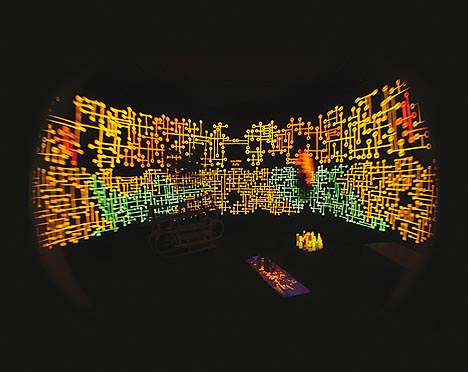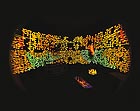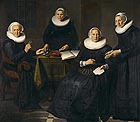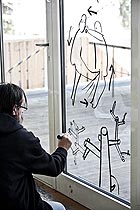
translated and summarized by: Liz Wollner-Grandville,
English summaries October 18 - 24
brut im Konzerthaus
sauna 2010 - Festival for extensive art
15.10.10 - 31.10.10
Chaos in the Sauna
This year, for the third time, Karl Kilian is organizing his festival entitled "sauna – Festival for extensive art": every two years from the word "go" the festival creates the newest and most interesting contemporaneous phenomena of the Viennese art scene and finds a common denominator, even if it is called "chaos". His festival manages to combine political incorrectness and every thinkable violation against a classical or whatever institutional curatoric concept, into an untouchable, clean position. And exactly because of this it seems to work – the art of giving back the freedom from discourse, concept, context, forced commercialization.
In a comment on one of his photographs on Facebook, Karl Kilian is described as "the epitome of civilized anarchy". This could also be true of the exhibition. The political incorrectness, as shown subtitled by the exhibiting artists in WomenArtists, MenArtists and in MixedGroups is, through the title "sauna" represented in the context of socialization as well as the classical segregation of the sexes in the sauna, thereby invalidating any objection against it. The expansion of the title "sauna – Festival for extensive art" is not by chance. "Art is a virus" was written on the flyer of the 2008 sauna festival.
As is so often the case when artists curate exhibitions, different things have also been brought together and arranged according to priority and aesthetic criteria.
In Viennese art happenings, which are known to have a measured amount of discussion and a fastidious concept, a rare refreshing approach wants to counteract the one-sidedness or border formation: An entire institution, "the white house" is presented as an artist under "WomenArtists".
At the end of the exhibition, the largest group of artists and artistic movement in the world will be established with the foremost goal of being entered in the Guinness Book of Records. The title: NO DOG! – HYPER FLUX! No dogmas, not even shrinking from mass entertainment as the Guinness Book of Records! And reading out the corresponding manifesto. Two extinct genres – art groups and manifesto are revived – to agitate against an art that has to agitate.
By Milena Dimitrova
Further presentations:
MenArtitst: 22.-24. October
MixedGroups: 29.-31. October
Link to the Live-program und all participating artists: www.karlkilian.com
Additional links to the „sauna 20 10– Festival für extensive Kunst:
Andreas Spiegl & Karl Kilian – Opening Speech on Youtube
Exhibition Impressions "sauna 20 10 - WomenArtists"
facebook
Kunsthistorisches Museum
The Golden Era – Dutch Group Portraits from Amsterdam's History Museum
09.09.10 to 21.11.10
Amsterdam's Golden Era in chiaroscuro
Construction work in museums brings up unexpected chances. Instead of being consigned to the depot or to the restoration workshops, 11 of Amsterdam's History Museum's group portraits from between the years 1596 and 1673 have arrived as guests of Vienna's Museum of Fine Arts. Before the pictures of the artists Frans Badens and Adriaen Backer, of Rembrandt's pupils Ferdinand Bol, Gerbrand van den Eeckhout, Govaert Flinck, Bartholomäus van der Helst, Nicolaes Eliasz Pickenoy and Dirck van Santvoort journey back north to the "Schuttersgalerij", they will sojourn in Munich.
The first impression on entering the room is stunning. At first, one feels scrutinized by the more than 100 pairs of eyes. The fantastically life-like faces with their white ruffs and collars appear in resplendent light in contrast to the dark clothing.
Four enormous defensive pieces hang on two sides of the room. Through the different poses which seem to have the effect of being slightly casual, the portrayed men's bodies appear form a front to the observer. They are counteracted by pictures of regents and guilds on the other two walls. In each case, the centerpiece is a table about which the less important persons – in this case also women – are grouped. The tables are covered by table carpets, some of oriental origin, thus indicating the financial potency of these citizens. In place of the carpet on one of the tables, a human body lies almost naked. "The Anatomy of Dr. Frederik Ruysch" by Adriaen Backer. But the men in the background – members of a surgeons' association – are not really observing the object of their research. They are gazing into space. The dissected body appears graceful and very lively.
The pictures were created with the purpose of bringing to light the newly found self-assurance that riches and clothing brought to those citizens who came to public office. One of the four painters represented here, Ferdinand Bol, was himself regent of a poorhouse.
In the present day, it is no longer fashionable to taken on an administrative position in a charitable institution in proportion to someone’s social advancement. And there is practically no ambition live by the motto "Do good and talk about it" or even to have oneself be painted by an artist.
Through a two-part photographic work, "Art Protectors" by Irene Andessner, a cautious attempt is make a connection to present-day art.
By Maria-Gabriela Martinkowic
Kunsthistorisches Museum
1010 Vienna, Burgring 5
www.khm.at
Opening hours: Tue - Sun 9.00 to 18.00
Stadtmuseum Graz
The Art of Assimilation. Styrian artists between tradition and propaganda during National Socialism
15.06.10 - 02.01.11
New standards
It is a real challenge as to how one should exhibit paintings and plastics, which originated during dictatorships. An answer was given in 2008 in the exhibition "Political Sculpture" in Linz's Landesgalerie even though in this project only a single "Nazi artist" –Josef Thorak – was represented. Nevertheless, the presentation and art of contextualizing can be considered as standard.
The Neue Galerie Graz is now also setting new standards with Günther Holler-Schuster's self-curated exhibition, "The Art of Assimilation. Styrian artists between tradition and propaganda during National Socialism" which, because of extensive alterations to the Joanneum, is being presented in the Stadtmuseum Graz.
Those apparently harmless landscapes hanging at the beginning of the exhibition (painted on the occasion of a Rosegger anniversary) ultimately represent the mainstream of NS art production: namely monumental propagandistic painting (such as one by Karl Mader) or sculpture (Hans Mauracher, Wilhelm Gösser). The exhibition has been cleverly divided into chapters – so you don't only devote yourself to the subject of the landscape but also to the sexist division of roles in National Socialism, the glorification of the heroes, the super-elevation of work. And one should also not forget to document the continued post-war existence of some pictures – for example, until 1949, Mader's "Mother" served as cover picture of the Mother’s Day edition of the "Stryrian News". Open to scrutiny, too, are isolated male artists – and surprisingly enough, many female artists – who continued to work after 1945: some suddenly painted abstract (inexpertly to some degree).
However, not only the content but also the arbitration has been approached with great sensitivity: the pictures haven't been hung at eye level – there, on a broad red stripe, detailed information is given about the artist and the art. The respective works are to be found above or below the stripe; the first glance falls on the factual level, after which one is confronted with the painting or drawing. Such a configuration can, perhaps, be perceived as didactic; however, in this case an intelligent solution has been found for the problem where others have failed. Everyone who ventures to present such an exhibition project in the future should reflect seriously upon this diligently thought-out show. And everyone else, too, as a matter of fact.
By Nina Schedlmayer
Stadtmuseum Graz
8010 Graz, Sackstraße 18
www.stadtmuseum-graz.at
Opening hours: Tue: 10.00 - 21.00, Wed – Sat: 10.00 to 18.00 Sun and Holidays: 10.00 to 18.00
Festivalzentrum im Stadtpark
Dan Perjovschi - Clear
25.09.10 - 02.11.10
Clear as glass – but not invisible
The Styrian Autumn has increasingly invested in its own projects, not only in large-calibre such as utopia and monumental, but also in the small and fine, such as marginal notes or individual artistic actions. One of these is by Dan Perjovschi who was represented last year within the Styrian Autumn's framework of the marginal notes. Perjovschi, who comes from Hermannstadt / Sibiu, has earned himself a place in the art world with his drawings which consist of simple strokes which metamorphose between cartoon and graffiti. He uses this course to reflect on, and react to, actual themes not only in society and economy but also those of everyday life. He began with the stress ratio between the European East and West and his oeuvres have meanwhile expanded to criticizing capitalism, the economic crisis, religious appearances or the mutation from real to virtual reality.
At the opening weekend of the Styrian Autumn, Perjovschi furnished the glass façade of the City Park's forum with his drawings. Watching the artist fill the glass wall was truly inspiring. A biting humor or irony can be detected in every drawing, whatever the theme may be - whether "Book – Facebook", or two people exchanging views on the fashion of the burqa or niqab or diesel or Levi's.
In any case, Dan Perjovschi interacts with the specific location of the Festival Centre; the glass façade which is dominated strongly by its inner and outer proportions, by the see and be seen. In 1984, Perjovschi was part of a Big Brother formation and he is still surprised by the fact of how some people press forward into the limelight. The fact that he himself stays true to his own form of artistic production doesn't influence the quality of his work.
By Nora Theiss
Festivalzentrum im Stadtpark
8010 Graz, Stadtpark
Mehr Texte von translated and summarized by: Liz Wollner-Grandville


 Teilen
Teilen





